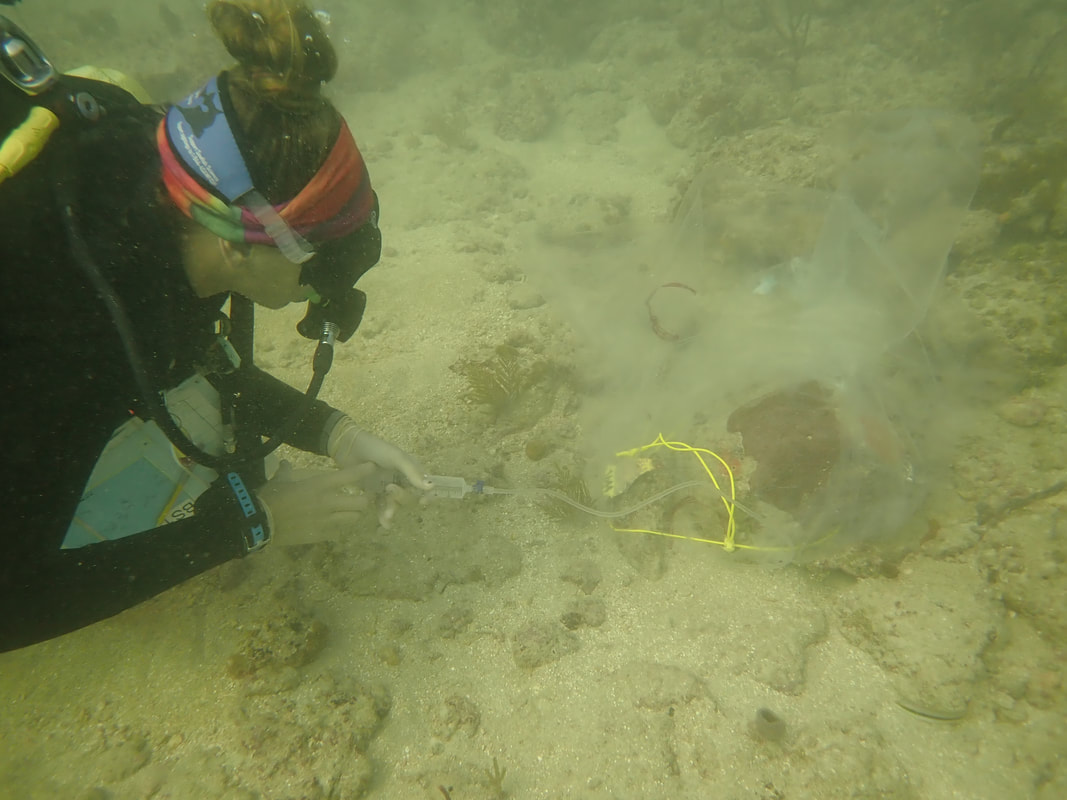Our research focuses revolve around the utilization of Geographic Information Systems (GIS) to better understand the underwater landscape and spatial distribution of reef fish and coral colonies. The laboratory uses GIS in a multitude of research areas including: Long-term large coral monitoring; Coral disease intervention; Restoration; SCTLD Resistance Research Consortium; Zooxanthellae Mapping; Coral Probiotics
Long-Term Large Coral Monitoring:The largest known coral colonies spanning from Broward to Miami-Dade county are prioritized for monitoring. This effort started in 2018 and is currently ongoing. 107 coral colonies have been tagged with a specific number and categorized as priority monitoring. Each coral is photographed and assessed by the lab's scientific divers every month. The condition and percentage of tissue- diseases, live, bleached- and the mortality - recent, old- are recorded during each monitory dive. Stony Coral Tissue Loss Disease (STCLD) is one of the main diseases the divers look out for and record. If STCLD is present on the colony, the team treats it with an antibiotic paste. The area treated, number of treatments, and treatment success are all recorded, as well. Each colony's specific location is recorded and uploading to a ArcPro layer and the data is uploaded and analyzed monthly in the statistic software R. The main objective of long-term large coral monitoring is to actively intervene during SCTLD outbreak proactively saving the colonies health and recording and analyzing changes in tissue coverage over time. |
|
|
|
Striketeam: |
|
|
Striketeam involves a group of divers conducting coral disease intervention along wide stretches of reef. The sites chosen are calculated from data where SCTLD was previously prevalent and areas where data may be insufficient A GPS connected to the dive flag is turned on at the start of each dive and records the track the divers survey. During this survey, Montastraea cavernosa (MCAV) and Orbicella faveolata (OFAV) colonies are counted and any SCTLD lesion observed are treated. This tagging, treatment, and data collection of condition and percentage of tissue and the mortality observed are recorded similarly to the large coral monitoring procedures. GPS coordinates are uploaded into ArcPro to provide a specific location of treated corals and mark dive tracks that were surveyed. Striketeam efforts are collaborative consisting of NSU, Broward County, and Miami-Dade County. The main objective of Striketeam efforts is to cover large distances of reef and treat as many diseased corals as possible increasing the chances of coral colony survival overall. |
Restoration:
|
Our lab is currently raising and propagating multiple genotypes of the locally important bouldering species, Orbicella faveolata, for the purpose of reskinning large wild colonies that have lost tissue from Stony Coral Tissue Loss Disease (SCTLD). By implementing the microfragmentation technique, we are asexually increasing the tissue we collect from corals of opportunity, which are coral fragments that have dislodged from the parent colony either by natural causes or anthropogenic degradation. We find during our monthly monitoring activities until we can outplant it back out onto the reef. The main objective of our coral restoration initiative is to restore the health, genetic diversity, and ecosystem function of these large charismatic and critically important colonies. |
Zooxanthellae Mapping:Zooxanthellae mapping involves understanding the the changes in symbiont identity and relative abundance between the symbiont, host, and algal genera within colonies of the vulnerable coral species, Orbicella faveolata. This project maps the Symbiodiniaceae across the OFAV colony over time and tests for associations of SCTLD. Tissue samples from these colonies are collected and characterized. Biopsy locations on the corals are traced on a 3D coral model created at each time of collection to evaluate spatial and temporal differences. This model is also analyzed using spatial statistics to determine the type of distribution pattern of symbiont communities and overlaid with documented SCTLD lesions to asses associated symbionts. Understanding the spatio-temporal changes in symbiont assemblages can provide insight on SCTLD susceptibility and better inform restoration practices in the future.
|
|
Collaborative Projects:
The lab assists with the following highly collaborative projects.
Coral Probiotics:
Probiotic treatments are being applied to corals infected with SCTLD in order to test the efficacy in halting the progression of the disease on Montastrea cavernosa colonies. Treatments are applied either as a paste or aqueous solution to the coral colony. These coral colonies are enclosed in bags to ensure the treatment is absorbed by the infected tissue. Tissue samples are also collected for metabolomics analysis and genome sequencing. This project is in partnership with the Smithsonian Marine Station Fort Pierce.
NCRMP:
National Oceanic and Atmospheric Administration's (NOAA) National Coral Reef Monitoring Program (NCRMP) is a long-term monitoring effort of coral reef health throughout the United States. The main focuses of this program is to identify themes and indicators for reef-associated benthic communities, fish communities, climate change resilience, and anthropogenic impacts and interactions. Our lab conducts surveys at a total of 215 sites, covering 215 fish surveys and 75 benthic surveys from Palm Beach County, FL to Miami-Dade County, FL.
To learn more, visit www.coris.noaa.gov/monitoring/
To learn more, visit www.coris.noaa.gov/monitoring/
|
|
SCTLD Resistance Research Consortium: |
|
The SCTLD Resistance Research Consortium (RRC) revolves around what factors make certain large (>2m diameter) Orbicella faveolata colonies more susceptible to SCTLD while making others more resistant. SCTLD progression throughout a colony can range from rapidly spreading killing the whole colony quickly to low mortality and the disease resolving on its own. Core samples are collected from large Orbicella faveolata colonies and analyzed in order to gain a better understanding of what factors within the coral may be driving the differences in disease resistance. These differences will provide insight on STCLD as a whole, advance treatment development, and improve restoration strategies. |









